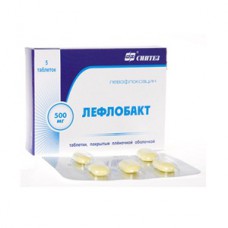Expiration date: 08/2026
Broad-spectrum antibacterial, bactericidal.Inside, regardless of meals, 250-500 mg 1 p / day.The duration of treatment depends on indication for use.
Pharmacological action
Antibacterial action broad-spectrum lies in the ability of antimicrobials to exert a bactericidal and/or bacteriostatic effect on a wide range of infectious pathogens
Interaction
With iron salts, antacids containing magnesium and/or aluminum. It is recommended that preparations containing divalent or trivalent cations such as iron salts (treatment for anemia), antacids containing magnesium and/or aluminum, to take at least 2 hours before or 2 hours after taking the pill. With calcium carbonate interactions have been identified. With sucralfate. The drug's effect is significantly attenuated with concomitant use of sucralfate (means for protection of the gastric mucosa). Patients receiving sucralfate and levofloxacin, it is recommended to take sucralfate 2 hours after taking levofloxacin. With theophylline, fenbufen or similar drugs from the group of NSAIDs that reduce the seizure threshold of the brain. Pharmacokinetic interaction levofloxacin theophylline was not detected. The concentration of levofloxacin at simultaneous reception of fenbufen increased by only 13%. However, concomitant administration of quinolones and theophylline, NSAIDs and other drugs that reduce the seizure threshold of the brain, possible a marked reduction in the threshold of convulsive readiness of the brain. Indirect anticoagulants, in patients treated with levofloxacin in combination with indirect anticoagulants (e.g. warfarin), there was an increase in PT/INR and/or development of bleeding, including severe. Therefore, while the use of anticoagulants and levofloxacin requires regular monitoring of indicators of blood coagulation. With probenecid and cimetidine. While the use of drugs violating renal tubular secretion of levofloxacin, such as probenecid and cimetidine, use caution especially in patients with renal insufficiency. The elimination (renal clearance) of levofloxacin slows down under the effect of cimetidine on 24% and probenecid by 34%. It is unlikely that this may have clinical significance in normal kidney function. With cyclosporine. Levofloxacin increased the half-life of cyclosporine is 33%. As this increase is clinically relevant, dose adjustment of cyclosporine in its concomitant use with levofloxacin are not required. WITH GKS. Concomitant use of corticosteroids increases the risk of tendon rupture. With drugs, extension QT interval. Levofloxacin, like other fluoroquinolones, should be used with caution in patients receiving drugs that lengthen the QT interval (e.g., antiarrhythmic drugs of IA and III class, tricyclic antidepressants, macrolides). Other. A clinical-pharmacological study to investigate the possible pharmacokinetic interactions of levofloxacin with calcium carbonate, digoxin, glibenclamide, ranitidine and warfarin showed that the pharmacokinetics of levofloxacin with the simultaneous use of these drugs is not altered sufficiently to have clinical significance.
Storage conditions
T=+(15-25)C
Testimony
Arabia mild to moderate bacterial infections that are sensitive to levofloxacin in adults. Acute sinusitis; worsening of chronic bronchitis; community-acquired pneumonia; uncomplicated urinary tract infection; complicated urinary tract infections (including pyelonephritis), chronic bacterial prostatitis; infections of the skin and soft tissues, septicemia/bacteremia associated with the above indications; infections of the abdominal cavity; the complex treatment of drug-resistant forms of tuberculosis.
Contraindications
Hypersensitivity (including to other hinolonam); epilepsy; lesions of the tendons when taking fluoroquinolones in history; childhood and adolescence till 18 years (due to the incomplete growth of the skeleton, because it is impossible to completely eliminate the risk of destruction of the cartilage growth points); pregnancy(do not completely eliminate the risk of injury of the cartilage of the growth points in the fetus); lactation (it is impossible to completely eliminate the risk of destruction of the cartilage of the growth points of bones in children).
Side effects
Heart: sinus tachycardia; prolongation of the QT interval. The blood and lymphatic system: leukopenia (decrease in the number of leukocytes in peripheral blood), eozinofilia (increase in the number of eosinophils in peripheral blood); neutropenia (decrease in the number of neutrophils in the peripheral blood), thrombocytopenia (reduction of platelets in peripheral blood); pancytopenia (decrease of all formed elements in the peripheral blood), agranulocytosis (absence or sharp decrease in the number of granulocytes in the peripheral blood), hemolytic anemia. From the nervous system: headache, dizziness; drowsiness, tremor, dysgeusia (taste perversion); paresthesia, cramps; peripheral sensory neuropathy, peripheral sensory-motor neuropathy, dyskinesia, extrapyramidal disorder, loss of taste, parosmia (disorder of the sense of smell, especially the subjective feeling of smell, objectively absent), including loss of smell. On the part of the organ of vision: visual disturbances such as blurring of the visible image. On the part of the organ of hearing and labyrinth disorders: vertigo (a feeling of rejection or whirling or of the self or surrounding objects); tinnitus; hearing loss. The respiratory system of the chest and mediastinum: dyspnea; bronchospasm, allergic pneumonitis. Gastrointestinal: diarrhea, vomiting, nausea, abdominal pain, dyspepsia; diarrhoea haemorrhagic which in very rare cases, it may be a symptom of enterocolitis, including pseudomembranous colitis. The kidneys and urinary tract: increased creatinine concentration in blood serum; acute renal failure (for example due to development of interstitial nephritis). The skin and subcutaneous tissue: rash, itching, hives; necrolysis toxic epidermal, Stevens-Johnson syndrome, exudative erythema multiforme, photosensitivity reaction (increased sensitivity to sun and ultraviolet radiation), leukocytoclastic vasculitis. Reactions of skin and mucous membranes may sometimes develop even after the first dose of the drug. On the part of the musculoskeletal system and connective tissue: arthralgia, myalgia; defeat tendons, including tendinitis (e.g. Achilles tendon) muscular weakness which can be especially dangerous in patients with psevdoparalitichesky myasthenia(myasthenia gravis); rhabdomyolysis, tendon rupture (e.g. Achilles tendon). This side effect may occur within 48 h after the start of treatment and may be bilateral in nature. From the metabolism and nutrition: anorexia; hypoglycemia, especially in patients with diabetes mellitus (possible signs of hypoglycemia: the "wolf" appetite, nervousness, perspiration, shakiness). Infectious and parasitic diseases: fungal infections, the development of resistance of pathogenic microorganisms. From vessels: decrease in blood pressure. General disorders: asthenia; pyrexia (increased body temperature). The immune system: angioedema; anaphylactic shock, anaphylactoid shock. Anaphylactic and anaphylactoid reactions may sometimes develop even after the first dose of the drug. The liver and biliary tract: increased activity of "liver" enzymes in the blood (e.g. ALT, AST); increasing the concentration of bilirubin in the blood; severe hepatic impairment, including cases of acute liver failure, especially in patients with severe underlying disease (such as sepsis); hepatitis. Psychiatric disorders: insomnia; anxiety, confusion; mental disturbances (such as hallucinations), depression, agitation (agitation), sleep disturbance, nightmares; psychiatric disorders with disturbances of conduct causing harm to themselves, including suicidal thoughts and suicide attempts. Other possible unwanted effects related to all of the fluoroquinolones: attacks of porphyria (a very rare metabolic diseases) in patients already suffering the disease. Other side effects (infusion dosage form): pain, redness at the injection site and phlebitis; General weakness (asthenia), fever. Any antibiotic can cause changes in the microflora (bacteria and fungi), which is normally present in humans. For this reason, may occur increased growth of bacteria and fungi resistant to commonly used antibiotics (secondary infection and superinfection), which in rare cases may require additional treatment.
Method of application and dosage
Inside, with liquid squeezed enough liquid (from 0, 5 to 1 Cup), before a meal or anytime between meals. Selection of dose pills you can break in a dividing groove. The drug should be taken at least 2 hours before or 2 hours after taking antacids containing magnesium and/or aluminium, iron salts or sucralfate. The dosage depends on the nature and severity of infection and sensitivity of the suspected pathogen. The duration of treatment varies depending on the disease. The recommended dosing regimen and duration of treatment in patients with normal or moderately reduced renal function (creatinine Cl>50 ml/min): Sinusitis (inflammation of the sinuses) — 2 table. 250 mg or 1 tab. 500 mg 1 time per day (500 mg of levofloxacin) is 10-14 days. Exacerbation of chronic bronchitis — 1 table. 250 mg 1 time per day (respectively 250 mg levofloxacin) or 2 table. 250 mg or 1 tab. 500 mg 1 time per day (500 mg of levofloxacin) for 7-10 days. Community — acquired pneumonia table 2. 250 mg or 1 table. 500 mg 1-2 times a day (respectively 500-1000 mg levofloxacin) is 7-14 days. Uncomplicated urinary tract infections — on 1 tab. 250 mg 1 time per day (respectively 250 mg of levofloxacin) is 3 days. Prostatitis — 2 table. 250 mg or 1 table. 500 mg 1 time per day (500 mg of levofloxacin) is 28 days. Complicated urinary tract infections including pyelonephritis, — 1 table. 250 mg 1 time per day (respectively 250 mg levofloxacin) for 7-10 days. Infections of skin and soft tissues: — 1 table. 250 mg 1 time per day (respectively 250 mg levofloxacin) or 2 table. 250 mg or 1 table. 500 mg 1-2 times a day (respectively 500-1000 mg levofloxacin) is 7-14 days. Septicemia/bacteremia — 2 table. 250 mg or 1 table. 500 mg 1-2 times a day (respectively 500-1000 mg levofloxacin) is 10-14 days. Infection of the abdominal cavity — 2 table. 250 mg or 1 table. 500 mg 1 time per day (500 mg of levofloxacin) — 7-14 days (in combination with antibacterial drugs acting on the anaerobic flora). Comprehensive treatment of drug-resistant forms of tuberculosis are on the table 1-2. 500 mg 1-2 times a day (respectively 500-1000 mg levofloxacin) — up to 3 months. Levofloxacin is excreted primarily through the kidneys, so in patients with impaired renal function require a lower dose of the drug. Relevant information about this is contained in the table. The dosage in patients with impaired liver function.When the liver does not require correction of dosing regimen, as levofloxacin is only slightly metabolized in the liver. The dosage regimen in patients of advanced age.For elderly patients do not require correction of dosing regimen, with the exception of reductions in creatinine clearance to 50 ml/min and below. The drug should be taken at least 2H before or 2H after intake of antacids, iron salts or receive sucralfate.
Special instructions
Such side effects of the drug, as dizziness or vertigo, drowsiness and visual disturbances may decrease psychomotor reactions and the ability to concentrate. This may constitute a risk in situations where these abilities are of special importance (e.g. driving a car, when servicing machines and mechanisms, when performing work in an unstable position).


